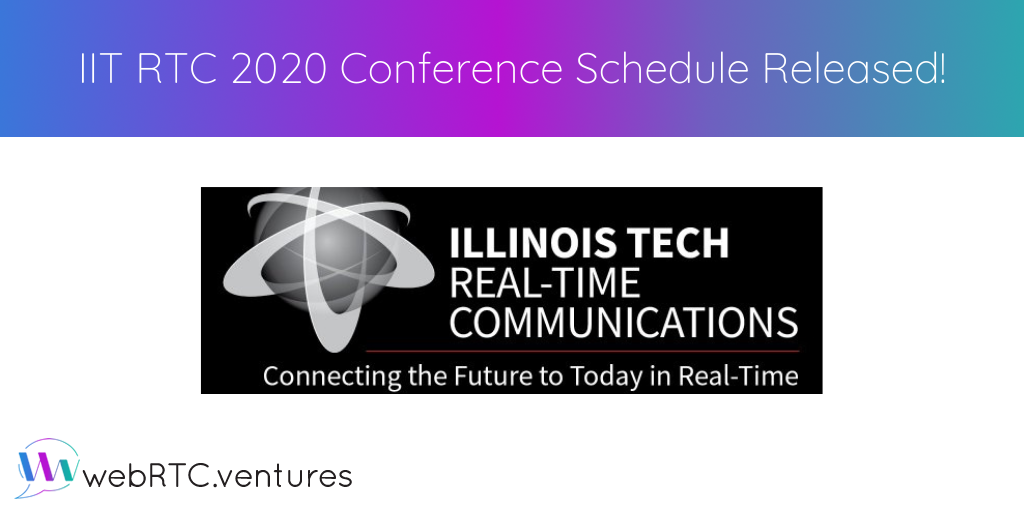I’m pleased to say that the 2020 IIT RTC conference is coming up quickly and we have a very exciting WebRTC and Real Time Applications track planned for you! You should register to attend the conference virtually right now – it’s free!
The conference will be hosted on HopIn this year, and we have a very impressive lineup of WebRTC thought leaders talking about topics including Scaling WebRTC, media servers, security, and more!
The overall conference runs from Tuesday Oct 13th until Thursday Oct 15th, with the WebRTC track running on the 14th and 15th. Don’t forget there is also a TADHack the weekend before which you can still join!
Without further ado, here is the schedule! All times are listed in US Central Time (GMT-5).
Can SFUs and MCUs be friends?
Lorenzo Miniero, Meetecho/Janus
Wed Oct 14, 9:30 – 10:00am US Central (GMT-5)
When talking about videoconferencing, there are usually two different roads you can take: you can either use an SFU (Selective Forwarding Unit) and have all media relayed as it is with no transcoding, or use an MCU (Multipoint Control Unit) instead to decode all streams and encode a composed mix of all the contributions. Both approaches have pros and cons, so picking one over the other is usually a matter of trade-off. It’s not always a binary matter, though: as a matter of fact, there are actually many cases where using both in an orthogonal way may make a lot of sense, in order to have one complement the shortcomings of the other, or extend the functionality you can get out of either when used on their own. This presentation will try to present some of these use cases, to show how SFUs and MCUs can actually be good friends, rather than strict and exclusive alternatives.
Building Dana The Stream Gatekeeper
Dan Jenkins, NimbleApe
Wed Oct 14, 10:00 – 10:30am US Central (GMT-5)
The problem with great WebRTC projects is always the lack of great front-end projects to show off their capabilities. Jitsi has Jitsi Meet, but other projects are usually lacking when it comes to showing off what they can do to others. Asterisk had this problem with their SFU; with their “Cyber Mega Phone 2000” project being a little bit of an eyesore, with users unable to go build off it. In comes “Dana – The Stream Gatekeeper” project – something to show off Asterisk’s capabilities – not just a WebRTC front-end; but a complete application to help show off Open Source comms – including live Transcription. In this session I’ll show you the project and how you can take it and build off it.
Real-Time Av1: the dawn of High-Quality, secure, self-adaptive Video in WebRTC
Dr Alex Gouaillard, CoSMo Software
Wed Oct 14, 10:30 – 11:00am US Central (GMT-5)
For a very long time, WebRTC has mainly been used in the Video conferencing industry and for p2p applications. It was missing some of the features the streaming industry had become accustomed to: ABR, high-resolution (4k@60fps, HDR, 4:4:4 chroma sampling, 12bits colors, no bandwidth limit. In comparison, the implementation of the webRTC protocol in browsers, which was used as a base for comparison was limited to 2 Mbps per stream, leading to compromises on quality: 1080p@30, 4:2:0, 8bits colors. ABR was not available, DRM or content protection was not available, and so on and so for. This talk will show how real-time AV1 is bridging the gap with usual streaming while keeping the real-time latency profile. ABR 2.0, E2EE for finer granularity DRM, 4k 4:4:4 HDR 10bits streams encodable in real-time on commodity consumer-grade PCs and laptop, everything will be presented, and comparison with other codecs all run in the same condition (i.e.) real-time mode over RTP media transport, will be provided, answering the usual questions: how much bandwidth can I save for same-resolution/same-quality? How much more taxing is the encoding compared to VP9, H264 software, and H264 Hardware? Finally an update on the status of HW support for AV1 will be presented.
Keynote – COVID19 and Video: Call Quality and Scalability from the Trenches
Emil Ivov, 8×8 and Jitsi
Saúl Ibarra Corretgé, 8×8 and Jitsi
Varun Singh, 8×8 and callstats.io
Wed Oct 14, 11:15 – 12:00pm US Central (GMT-5)
During 2020, millions of people around the world have experienced an unprecedented change in their daily routines due to the global pandemic caused by the novel COVID-19 virus. This created a large increase in remote work and video calls, and in this keynote the Jitsi and callstats.io teams will jointly present on the impact of Shelter-in-Place mandates on video call quality and what they learned about scaling video solutions. Varun Singh will present data from millions of video and audio calls in over 1000 WebRTC apps to help paint a picture of some of the changes to usage and call quality between Jan 1 to April 30, from large cities in Continental North America, the San Francisco Bay Area, and the East and West Coasts of the United States. Emil Ivov and Saúl Ibarra Corretgé will also tell the story of how a small but highly motivated team took on the challenges of 2020 and managed to accomplish their mission of providing the best meeting experience to an unprecedented amount of people. Saúl will share the lessons they learned the hard way, on how they achieved the level of scalability required, while being able to iterate fast on the features that were most needed.
TADHack Global Hackathon Results
Alan Quayle, TADHack (Register your team today!)
Wed Oct 14, 12:45 – 1:15pm US Central (GMT-5)
The weekend before the IIT RTC Conference is the largest Real Time Communications hackathon in the world. For 7 years straight, the IIT and the Chicago developer community have been part of TADHack. This year we’ll share the results of interesting hacks from Chicago and beyond. Showing how real time communications can solve problems across our home, work and community lives.
Pion: Solving Production RTC problems with composable Open Source Go libraries
Sean DuBois, Pion.ly
Wed Oct 14, 1:15 – 1:45pm US Central (GMT-5)
Pion is used for all the traditional RTC problems (SFUs, Protocol Bridging, Clients). Instead let’s talk about the unique production problems it is solving. Come learn why Pion is the software for large scale broadcasting, self driving cars and robots. This is what developers do when real world constraints hit. We are going to talk about problems like modifying ICE so you can massively scale servers, replacing DTLS (without any code modifications) to pass security reviews, using Go code on Android/iOS/Servers/Desktops and Web with one code base, attempting to build the first ‘Cloud Native’ WebRTC deployment, and integrating with other great Go libraries with zero glue code. At the end, we will have a tour of popular Open Source projects using Pion to let people live gaming stream, synchronize browsing sessions to watch videos with friends, share files across Native/Web with no backend, and seed and download WebTorrents.
What’s New In WebRTC
Bernard Aboba, Microsoft
Wed Oct 14, 1:45 – 2:15pm US Central (GMT-5)
This talk will go over new developments in realtime communications for the Web, including the QuicTransport, Insertable Streams, WebRTC-SVC and Content-Hints APIs.
The WebRTC Track will continue on Thursday October 15th with the following two excellent sessions, don’t miss them!
Panel Discussion: How has the pandemic changed WebRTC?
Moderator: Chad Wallace Hart, webrtcHacks & cwh.consulting
Panelists: Tsahi Levent-Levi, TestRTC, blogGeek.me
Ole Eichhorn – CTO, Teladoc Health HHS
Fernando Lapa – Network Engineering Manager, Talkdesk
Thu Oct 15, 12:45 – 1:45pm US Central (GMT-5)
The global coronavirus pandemic of 2020 has changed so much in our world, and the WebRTC ecosystem is no exception. In this panel, our industry experts will discuss how WebRTC development and use cases have changed in 2020, what changes are temporary, and what’s going to stay with us indefinitely as part of the new normal
How to Secure Your WebRTC Application
Natalie Silvanovich, Google
Thu Oct 15, 1:45 – 2:15pm US Central (GMT-5)
Recently, there have been attacks against video conferencing systems that have allowed access to calls, user data and even users’ entire systems. This presentation explores the technical aspects of these attacks and how to avoid them. It will discuss vulnerabilities in WebRTC, and how integrators can protect against them, as well as common design mistakes made in video conferencing applications. Attendees will learn how to make applications that integrate WebRTC more secure.
Register today for this excellent (and free) WebRTC content at the 2020 IIT RTC Conference!




